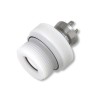A 4-20mA current signal has become very popular for many applications beyond it’s original intended purpose in the process industry. It is now used throughout industry as the preferred measurement and control signal for many different types of systems.
Despite the popularity of the 4-20mA signal, it is not the best solution for every application and here are some of the ‘for’ and ‘against’ reasons for determining whether it is the right type of signal for your application.
Featured 4-20ma signal related products
 DMP331P Hygienic Flush Pressure Transmitter - Sanitary pressure sensor wth exposed diaphragm with no crevices for high temperatures up to 300 Degrees Celsius in ranges from 100mb up to 40 bar gauge or absolute
DMP331P Hygienic Flush Pressure Transmitter - Sanitary pressure sensor wth exposed diaphragm with no crevices for high temperatures up to 300 Degrees Celsius in ranges from 100mb up to 40 bar gauge or absolute 4-20mA Output Hydrostatic Level Transmitters & Sensors - Explore industrial 4-20mA hydrostatic level transmitters for reliable liquid depth measurement. Ideal for tank gauging, borehole control & process monitoring applications.
4-20mA Output Hydrostatic Level Transmitters & Sensors - Explore industrial 4-20mA hydrostatic level transmitters for reliable liquid depth measurement. Ideal for tank gauging, borehole control & process monitoring applications.
Advantages
- It can be run over long distances with minimal signal losses compared to voltage type signals
- A varying current loop load impedance or supply voltage will not significantly affect the signal as long as it does not exceed recommended component limits
- Rugged signal with low electromagnetic susceptibility
- Saves on cable wire because it only needs 2 wires to function
- Live zero reading verifies sensor is electrically functional
Disadvantages
- High power consumption compared to other analogue signal types
- Elevated output at zero reading
- Supply not isolated from output
- Increasing circuit load resistance, will reduce the supply voltage available to power the transmitter that is generating the 4-20mA signal.
Featured 4-20ma signal related products
 Water Level Transmitters with 4-20mA Output - Browse for 4-20mA water level transmitters using two-wire loop power. Ideal for wells, tanks, rivers & reservoirs with excellent noise immunity & long cable runs.
Water Level Transmitters with 4-20mA Output - Browse for 4-20mA water level transmitters using two-wire loop power. Ideal for wells, tanks, rivers & reservoirs with excellent noise immunity & long cable runs. Chemical Resistant Pressure Sensor Elements for Electronic Devices & Embedded Product Design & Development - Pressure sensor elements with sensing diaphragms made from alumina ceramic (Al2O3) for electronic & mechanical oem integration into measurement & control instrumentation designs.
Chemical Resistant Pressure Sensor Elements for Electronic Devices & Embedded Product Design & Development - Pressure sensor elements with sensing diaphragms made from alumina ceramic (Al2O3) for electronic & mechanical oem integration into measurement & control instrumentation designs.
Related Help Guides
- Choosing calibrator for pressure transmitters
- How to create a list of specification parameters for a pressure sensor
- How do you measure flow rate with a dp cell
- Why use 4-20mA and 3-15 psi rather than 0-20mA & 0-15psi
- Supply voltage and load resistance considerations for pressure transmitters
- How to Connect a 4-20mA Current Loop Pressure Transmitter
- Transforming a 2 wire Current Loop into a Voltage Output Signal
- How to get a 10 volt signal from a 4-20mA output pressure sensor
- What is the difference between a pressure transducer and a transmitter
Related Technical Terms
- 2 Wire
- 4 to 20 mA Current Loop Output Signal
- HART®
- Square Root Extraction
- Stainless Steel Pressure Sensors
- Transmitter
- Turndown Ratio
Related Online Tools
- Pressure Transmitter 4-20mA Current Output Calculator
- Flow Transmitter 4-20mA Current Output Calculator
- DP Flow Transmitter Output Calculator
- 4-20mA Signal to Measurement Reading Converter
- SqRt Extraction 4-20mA Signal to Measurement Reading Converter
- Temperature Transmitter 4-20mA Current Output Calculator
- Liquid Level Transmitter 4-20mA Current Output Calculator
- 4 to 20 mA Supply, Load, Shunt and Signal Calculator
- 16 bar, 200°C steam pressure transmitter and gauge
- Vacuum suction sensor & wall mount digital readout with switched contacts
- Stainless steel 316L wetted parts 100 mbar ATEX pressure transmitter
- 5 to 20 psi absolute ambient 4 to 20 ma pressure transmitter
- Water temperature depth sensor for cooling tower sump
- Solvent compatible +/-100mWG dp transmitter with PTFE seals
